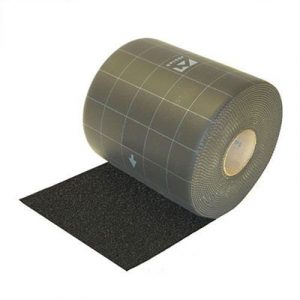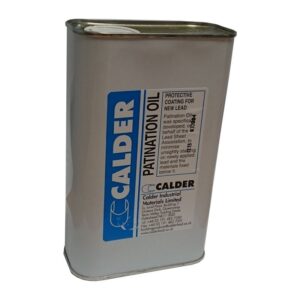Lead flashing is commonly used to weatherproof any part of a roof where there is a join. It’s sturdy and durable and has a fantastic lifespan.
That being said:
It still requires some aftercare following installation.
You’re probably wondering:
What cleans old lead?
And what is the best cleaner for lead?
At Drainage Superstore, we’re here to help! That’s why we put together this handy guide on how to clean lead flashing that will hopefully answer all your questions.
Let’s crack on.
Table of contents:
- How to clean stained lead flashing
- How to apply patination oil for lead
- Can you paint lead flashing?
- Final thoughts
How to clean stained lead flashing

If lead flashing is left untreated after installation, it might react with moist air, resulting in the build-up of lead carbonate (PbCO3). This white, powdery substance can create ugly white stains all over your beautiful roof.
And you definitely don’t want that.
The good news is:
It’s not too difficult to repair the damage if you do it straight away. Besides, you’ll only need a few simple tools.
Before cleaning lead, make sure you’re wearing protective safety gloves. Then, get up on the roof and sweep away any dirt, debris and leaves covering the flashing. Proceed to examine the stains carefully to determine which type they are.
Here are the most common types and how to deal with them.
Light white stain
As we mentioned, light white stains tend to appear on newly fitted lead flashing which has not been treated with patination oil for lead (more on what this is later) due to lead carbonate build-up.
These are quick and easy to clean. All you have to do is treat them with undiluted white vinegar or a similar weak acid solution and scrub them off with fine wire wool, thick cloth or a nylon brush.
Heavy white stain
If an acid-curing silicon sealant has been used when the lead flashing was first laid, it might cause a chemical reaction that will produce heavy white stains.
The best course of action here is to remove the problematic sealant before cleaning the lead flashing with vinegar and re-installing it with a non-acid sealant.
If the white stains are particularly tough and have been there for a while, you might have to use something stronger than vinegar, such as specifically produced lead flashing cleaner.
Rusty stain
Orange, rusty-looking stains sometimes appear when lead flashing is kept in damp locations prior to installation. This will result in moisture being trapped between the sheets and will facilitate oxidation.
To remove these nasty stains, you’ll have to apply lead cleaner and restorer with a cloth or a nylon brush. That’s how to clean oxidized lead.
Bright red stain
Last but not least, you might come across red stains when cleaning lead flashing. These are usually caused by water running off from copper fixings over the lead flashing. You can use a strong detergent to wipe them off with fine wire wool or a nylon brush.
Whichever type of stain you’re dealing with, make sure you pat the lead flashing dry before moving on to the treatment phase.
How to apply patination oil for lead

The formation of virtually any stains could be avoided in the first place if lead sheets are treated with patination oil for lead flashing immediately after being laid.
The question is:
What exactly is patination oil? And how do you use it when cleaning lead flashing?
Check this out:
Patination oil is a white-spirit-based surface treatment which prevents the formation of carbonate on lead surfaces and significantly reduces the risk of staining.
Before opening the container, make sure you shake it vigorously for about two minutes. This way, the sludge at the bottom will be thoroughly mixed with the rest of the liquid.
Next:
Using a clean, soft cloth, apply the patination oil to the clean lead flashing. Work in straight lines, either horizontally or vertically. A single thick coat should be sufficient to get the job done.
However, if working with older lead flashing, it’s a good idea to apply a second coat. Simply wait for the first one to set and then go over the entire area once more. This should ensure your clean lead flashing stays clean even when faced with harsh weather conditions.
Can you paint lead flashing?
While it’s possible to paint lead flashing, we wouldn’t recommend it.
Here’s why:
Lead will contract and expand quite a bit depending on the temperature. It will also oxidize, which will lift the paint.
All of this means that the paint will inevitably crack and peel before too long.
So, instead of painting your lead flashing only to have to do it over and over again, a simple application of patination oil will result in an elegant, darkened lead colour.
But how do you deal with old lead flashing paint that’s already there?
This is how to clean paint off lead flashing:
The best and safest way is to use a chemical stripper. This product binds the paint particles and doesn’t create loads of dust. Keep in mind that lead is toxic, so you want to be in close contact with it as little as possible.
To maintain the enhanced appearance of your lead flashing, simply reapply a coat of patination oil once every couple of years.
Final thoughts
And there you have it:
Cleaning lead is something you can do quickly and efficiently with the help of a few simple products like white vinegar, patination oil and, if necessary, lead sheet cleaner.
Key takeaway:
The quick application of patination oil immediately after the lead flashing has been laid is crucial.
But even if for some reason patination oil treatment has been overlooked, it’s not the end of the world.
And now that you know exactly how to clean lead flashing, you should be able to repair the damage in no time, making sure your lead flashing continues to do its job for a long time.





